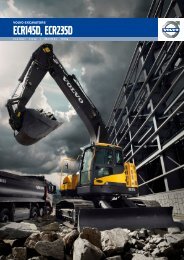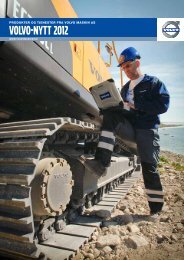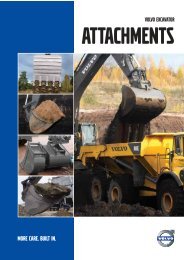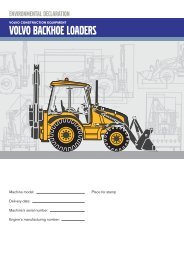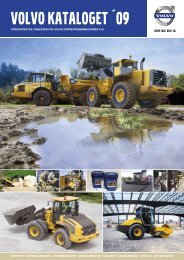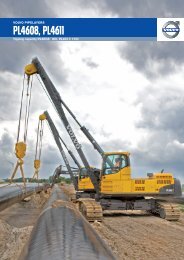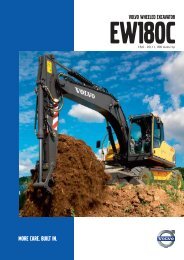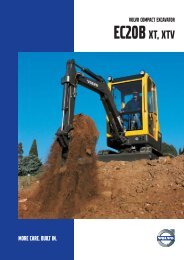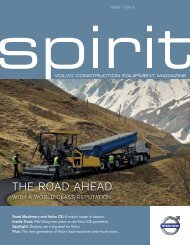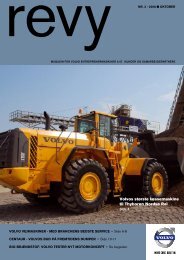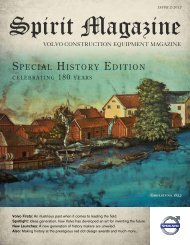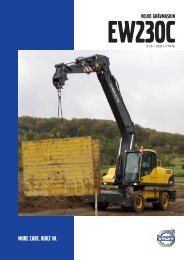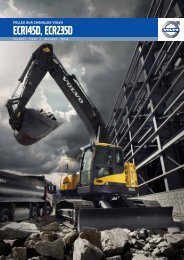Spirit 32 - Volvo Construction Equipment
Spirit 32 - Volvo Construction Equipment
Spirit 32 - Volvo Construction Equipment
Create successful ePaper yourself
Turn your PDF publications into a flip-book with our unique Google optimized e-Paper software.
AUGUST 2009 ISSUE <strong>32</strong>piritVOLVO CONSTRUCTION EQUIPMENT MAGAZINETOTAL SOLUTIONSINDUSTRY LEADING PRODUCTS AND WORLD CLASS SERVICESSpotlight: Keeping machines running and customers happyNorth Africa: <strong>Volvo</strong>s working on Algeria’s massive East-West highwayOperator Corner: Zhou Jiandong, a man helping to fuel China’s economyAlso: Product information, job reports and much more…
<strong>Volvo</strong> <strong>Construction</strong> <strong>Equipment</strong> MagazineAugust 2009 Issue <strong>32</strong>contents5 Going Underground in OsloAn exclusive fleet of <strong>Volvo</strong> constructionequipment is helping to tunnel through tough,rough Norwegian rock in an ambitious plan toupgrade the capital’s railway network.9 Inside TrackKatarina Lindström, one of Sweden’smost influential women leaders from <strong>Volvo</strong>Powertrain, explains her quest to deliverconstant improvement to the customer.13 A Clear Path Through the WoodsHow <strong>Volvo</strong> is helping customer growth with atotal solution approach in forestry.33 <strong>Volvo</strong> Embarks on a North AfricanAdventureOnce dubbed the biggest project of its kind inthe world, 150 <strong>Volvo</strong>s set to work on Algeria’smassive East-West highway.41 When only Rock Solid Reliability will doThe Seng Hong Quarry in Malaysia neededmachines that would never slow down, letalone stop. <strong>Volvo</strong>’s construction equipment hasexceeded all expectations.44 Operator CornerChina has enough coal to sustain its economicgrowth for a century or more, but demandis currently outpacing production, so <strong>Volvo</strong>operator Zhou Jiandong has a lot of work to do.Total Solutions – meeting and exceeding customer demands.Owning a construction machine is not a goal in itself. What customers need is for materialto be moved, dug, lifted or levelled. <strong>Construction</strong> tools simply provide the solution to getthe job done. When you look at equipment in those ‘solutions’ terms it is clear there ismore to meeting the demands of a customer than simply selling a machine.This ‘total solutions provider’ philosophy, which is the focus of this edition of <strong>Spirit</strong>,is at the core of <strong>Volvo</strong> <strong>Construction</strong> <strong>Equipment</strong>’s offering. This is not one sided: Manycustomers want to build long-term relationships around total solutions in order to do theirwork as efficiently as possible with maximum profitability and up-time. <strong>Volvo</strong> <strong>Construction</strong><strong>Equipment</strong> also offers services such as financing and insurance, various forms of serviceagreements, accessories and spare parts to support core products. The company’sincreasingly broad range of these so called ‘soft’ products has evolved into a distinctcompetitive advantage.In this edition of <strong>Spirit</strong> there is a profile on the high demands placed on <strong>Volvo</strong>’s servicetechnicians and parts specialists. With a global mission to keep the <strong>Volvo</strong> fleet runningin the toughest applications and climates these technicians support customers meet theirdeadlines, deliver on their promises – and grow their businesses profitably.Another key component in providing ‘total solutions’ to customers is the ability to offer acomplete range of products that can work together to handle the diverse requirementsneeded in different construction jobs. Our magazine reports this month show how <strong>Volvo</strong>’sbroad range of machines are being used in a variety of applications, including the latestofferings in our forestry range, tunnelling work as well as road construction machinery inthe unforgiving conditions of the African desert.In these dark economic days, customer profitability is more important than ever.Providing reliable machines that work well together, are effective and efficient – and arefully supported – are important elements in achieving that businesssuccess. So whether you need material moved, lifted, dug, laid orlevelled, as this copy of <strong>Spirit</strong> demonstrates, <strong>Volvo</strong> <strong>Construction</strong><strong>Equipment</strong> not only has the machines to do the job – it has thetotal customer solution.I hope you enjoy reading this issue.Bill Law Editor in ChiefPUBLISHED BY <strong>Volvo</strong> <strong>Construction</strong> <strong>Equipment</strong>EDITOR IN CHIEF Bill Law Assistant EDITOR Audrey GrandjeanEDITORIAL PRODUCTION AND DESIGN EMG Communications LtdCONTRIBUTORS Dan Brown, Niall Edworthy, Tony Lawrence, Fiona McLelland, Brian O’Sullivan, Dan WaddellPHOTOGRAPHY Julian Cornish TrestrailPlease send your editorial correspondence to <strong>Volvo</strong> <strong>Spirit</strong>, <strong>Volvo</strong> <strong>Construction</strong> <strong>Equipment</strong>, Hunderenveld10 – 1082 Brussels, Belgium or by e-mail to volvo.spirit@volvo.com.All rights reserved. No part of this publication (text, data or graphic) may be reproduced, stored in adata retrieval system or transmitted, in any form whatsoever or by any means, without obtaining <strong>Volvo</strong>CE’s prior written consent. <strong>Volvo</strong> <strong>Construction</strong> <strong>Equipment</strong> does not necessarily endorse the views orfactual accuracy of the articles in this issue. Four issues per year – printed on environmentally friendlypaper.www.volvoce.com/global
ADVERTORIALHOW TO MAKE IT BIG ON BROADWAYGoingUndergroundin OlsoSome things simply don’t need explaining.Take Times Square.Everyone knows. Times Square spells excitement,Broadway theatre, bright neon lights.Take <strong>Volvo</strong>.Everyone knows. <strong>Volvo</strong> spells quality, safety, environmentalcare. Not, of course, that everyone knows about our new,cutting-edge milling machines just yet.New York City’s Department of Transportation fi rst heardabout our half-lane, front load, 610-horsepower MT2000earlier this year.So a demonstration was arranged. And, since TimesSquare spells excitement, why not stage it right there,at the “Crossroads of the World”?We like to think the MT2000 put on quite a show duringits 30-hour dress rehearsal. The city’s operators certainlygave it a fi ve-star billing. They loved the performance, thecontrols, stability and maneuverability. Actually, they lovedpretty much everything.It’s a <strong>Volvo</strong>, after all. And everyone – even in Times Square– knows what that spells.With 5km (3.1miles) of tunneling through hard Norwegian rock,the Lysaker to Sandvika railway line is set to increase traffic intoOslo’s metropolitan area. Contractor NCC is using an exclusivefleet of <strong>Volvo</strong> construction equipment to maintain progress.SPIRIT4SPIRIT5
“The key support to the project is a <strong>Volvo</strong>L350F wheel loader. Fitted with extra lightsand a side-tipping bucket.”Norway has a lot of tunnels. Over 4,700km(2,900miles, more than 50% hydro power tunnels) of them,in fact. It’s not that the 4.6 million inhabitants have a particularaffinity for making life hard for themselves, but rather becauseNorway is a rocky, rugged, mountainous land where it’s simplyeasier to dig through rather than climb over. This experience hasmade Norway a centre of excellence in drill-and-blast tunnelingtechniques through hard rock. The stability of its solid, veryold, largely Gneiss rock – which is up to 3.5 billion years old– reduces the need for additional support. This means that,coupled with a higher speed of progress, the price of tunnelingin Norway is only a fraction of what it costs to tunnel throughweaker or softer rock.Norway’s infrastructure has struggled to keep up withthe demands of its busy population, especially around its capital,Oslo, where up to a quarter of the population live. As part ofan ambitious plan to upgrade the national rail network, a 20km(12.4miles) long double line railway is being built from Lysakerto Sandvika – from the west of Oslo into its center. The newline will make extensive use of tunnels and dramatically increasetransit speeds and capacity for both passenger and freight railtraffic. The key part of the project is a 5km (3.1miles) tunnel,of which global contractor NCC has the $57 million contractfor building 1.8km (1.1miles) of it.Clear line of sightThe tunnel’s dimensions are 13.2m wide by 9.5mhigh (43ft by 31ft), and depth-of-cover ranges from 2m to60m (6.5ft to 197ft) below ground. NCC’s constructionmanager Simen Thorsen, himself an experienced tunneller,modestly describes the project as ‘relatively straightforward’.“What complicates matters is the geometry of the installations,”he says. “Cutting the niches for the rail infrastructure, andcreating a tunnel profile that allows train drivers a clear line ofsight to rail signals needs careful attention. Because of this weare using the latest technology to make sure we get it right.”The tunnel was first considered to be built usinga tunnel boring machine (TBM), but night-time noise andvibration working restrictions meant that a drill-and-blastapproach was considered a more efficient method. (It’s less noisyto clean up and preparation work can be conducted at night,allowing continuous progress.) An advanced Norwegian-builtjumbo drill, at the sharp end of the project, is being assisted byan exclusively <strong>Volvo</strong> team of construction equipment.The team is making up to 45m (147ft) of progressper week, each blast gains 5m. Drilling of up to 200m (656ft)an hour is taking place, and every third blast a process ofinjecting cement grout is conducted to provide waterproofingsupport and preserve the water table. This is not the onlyenvironmental measure: noise, dust and vibrations are all closelymeasured. All water on site is recycled and purified, so that it isalmost as clean as drinking water.The key support to the project is a <strong>Volvo</strong> L350Fwheel loader. Fitted with extra lights and a side-tipping bucket,its role is to load the project’s three <strong>Volvo</strong> A40E articulatedhaulers with blasted rock. The haulers are a perfect matchfor the L350F – whose capacity equates to four passes of theL350F’s bucket. Central to the operation and with no back-upmachine in support, the L350F simply can’t break down. Sincearriving on site in February 2008, it simply hasn’t. The site alsohas Norway’s first EW210C wheeled excavator, fitted with aspecial tilting cab and rock scaler attachment, which removesany loose rock left by the blasts up to the tunnel’s full 10m(33ft) height.Other machines on the project are a <strong>Volvo</strong> L90Ethat is doing fetch and carry duties and a pair of <strong>Volvo</strong> BL71backhoe loaders with trailer fitted for carrying drainage pipes.The project’s ‘mascot’ is a 1970s vintage <strong>Volvo</strong> BM 4300wheel loader with over 30,000 hours on the clock –and still working hard.SPIRITSPIRIT
INSIDE TRACKKatarina LindströmReloading stationBecause much of the site runs through an urbanarea, there are also time limits on when rock can be movedout of the site. This could create a backlog of blasted rockat the tunnel face, which would cause delay. To overcomethis NCC has invested“On this job we have madesuch good progress that weare well ahead of schedule.”in the construction of aspecially built subterranean‘reloading station’ thatallows the high capacityremoval of spoil from thetunnel face. The loadedhaulers take blasted rockand dump their loads downa shaft into a manmade chasm 25m (82ft) below sea level. Herea <strong>Volvo</strong> L180E loads a team of on-highway tipper trucks thatgain access via a specially built tunnel. “In one week the L180Eloaded 12,186m 3 (430,000 ft 3 ) of blasted material – so we’vekept it busy,” says Simen. The rocks are then dumped in nearbyDrammen for reuse as rock amour for a new harbor that isbeing built.“The drill and blast process means that there isplenty of time for maintaining our machines properly,”continues Simen. “This is important as if any machine breaksdown the whole process falls apart. But if you treat machineswell they should not stop. On this job we have made such goodprogress that we are well ahead of schedule and have exceededthe theoretical maximum advance for several weeks in a row.You always need a bit of luck with tunneling – but that’sexceptional progress.”Text: Brian O’Sullivan“It’s a bit of a fluke that all the machines on this jobare from <strong>Volvo</strong>,” smiles Simen. “To make matters worse weare also just starting to use a <strong>Volvo</strong> SD160DX compactor andconsidering using a <strong>Volvo</strong> G946 motor grader. But althoughthe L350F is really the key machine, we get good support from<strong>Volvo</strong>. Our <strong>Volvo</strong> sales manager Olav Moi has been lookingafter NCC since 1969 – over 40 years.”SPIRITFrom <strong>Volvo</strong> Powertrain, the <strong>Volvo</strong> arm responsible for production of engines,gearboxes and drivelines.SPIRIT
“We have a common working culture and that is – that we should never be satisfied.”Katarina Lindström, Senior VicePresident of Manufacturing at<strong>Volvo</strong> Powertrain exudes energy andgood humor – and well she might. She wasvoted one of Sweden’s most influentialwomen leaders and all this in a traditionallymale dominated industry. She is also theperson responsible for overseeing theimplementation of the new <strong>Volvo</strong> ProductionSystem at <strong>Volvo</strong> Powertrain and feels herdepartment, and the group as whole, are onthe cusp of great things.It has taken three years of hardwork but she seems undiminished by thechallenge. Quite the opposite. Sat at her deskin Gothenburg, Katarina Lindstrom extols thebenefits of the <strong>Volvo</strong> Production System (VPS)and the transformation it can bring. While thesystem is in its infancy, and there are still a fewsites that are in the early stages of implementation,the first signs are more than encouraging.“Since we have introduced VPS,we have seen very positive movements inmany areas. We are building a common wayof thinking and doing things, which means weare speaking the same language,” she enthuses.“For us in <strong>Volvo</strong> Powertrain, thisis excellent. When we speak to our customerswe know the foundation of how we shouldoperate, which is a strength for us in thefuture. We have a common working cultureand that is – that we should never be satisfied.We should be proud of finding the problems,because every problem is an opportunityto improve.”“Now we have a common platform andcan guarantee the quality of ourproducts wherever they are sold.”The last comment resonates. It’s obviously a viewin which Katarina believes strongly, an ethos developed duringmore than two decades with the company.“If you really build that belief into a company thenyou will not stand still, you will always improve. That is whatour customers want to see – continuous improvement.”A common culture, harmonization, shared bestpractice, all the tenets of the <strong>Volvo</strong> Production System areones that Katarina has propounded during her time at <strong>Volvo</strong>Powertrain.In 2005 she started in her present role and with asmall team set about developing a set of processes and systemsthat could be introduced across all <strong>Volvo</strong>’s manufacturing sitesand plants across the world.It was an arduous process – not one plant had thesame system as another – yet eventually it was rewarding. “Itmeant taking the processes we had, seeing what we could learnfrom other parts of the company and other regions and seeinghow we could improve those processes, and then implementthem across different sites.“It has been a privilege to integrate the differentcultures, different ways of doing things, and learn the best wayforward. Now we have a common platform and can guaranteethe quality of our products wherever they are sold.”Katarina is a keen advocate of the view that it is theglobal nature of firms such as <strong>Volvo</strong> <strong>Construction</strong> <strong>Equipment</strong>(CE) that give them their strength, particularly in times ofuncertainty and upheaval.“There are always different perspectives on eachproblem and we can use these to forge a common perspectiveand be more competitive for the future. <strong>Volvo</strong> CE is such aninternational group and their structure puts them in a positionto use all the local knowledge to be truly successful.”SPIRIT10SPIRIT11
Despite her efforts in developing the commonplatform for <strong>Volvo</strong> Powertrain and implementing the VPS,Katarina does not seem one to rest on her laurels. She knowsmany challenges lie in wait, not least the intemperatefinancial climate.A clear paththrough the woods“The challenge right now is really to follow themarket development and anything it throws up. Since Istarted in this position we have had to manage the enormousupturn and now we can have to manage the downturn. <strong>Volvo</strong>Powertrain is supplying to all our customers, and we have tomake sure we are co-coordinating our activities efficiently.”On the subject of new technologies, her answercomes with a hint of pragmatism, suggesting that while theyneed to integrate new technologies as quickly as possible, <strong>Volvo</strong>can never lose sight of what the customer and the market want.She cites working close to the market as one ofthe exciting parts of her job. “Our role in <strong>Volvo</strong> Powertrainis to meet the customer’s demand and at the same time createsynergies for the <strong>Volvo</strong> Group, based on our product strategy.It has been a privilege to work with customers and learn whatwas really needed by the different business areas.”Katarina first joined <strong>Volvo</strong> after graduating inmaterials science from the Royal Institute of Technology inStockholm, working at the foundry in Skovde, before leaving forGothenburg and a role as Program Manager for the new 13 literengine. Two years later she moved to another position within<strong>Volvo</strong> Powertrain, heading up product planning, a position sheheld until 2005.“THE CHALLENGE RIGHT NOW IS REALLY TOfOLLOW THE mARKET DEVELOPmENT ANDANYTHING IT THROWS UP.”<strong>Volvo</strong>, for her, is a family affair. Husband Stefanalso works for <strong>Volvo</strong> Powertrain, though as he’s in the productdevelopment laboratory they rarely bump into each other. Witha mischievous glint, she describes her other role in life as amother of two – son Richard, 14, and daughter Caroline, 10 –as ‘logistics provider to two children’. When time and familyallow her to escape, a country girl at heart, she loves to ski andhunt, mainly deer, birds and moose. It’s a good way to get outof the world of work, commune with nature and reconnect withher country upbringing in Falkoping.Text: Dan WaddellPhotography: Julian Cornish TrestrailHow <strong>Volvo</strong> is helping customer growthwith a total solution approach.SPIRIT12SPIRIT13
scheme is that, starting with the original quotation, customersare given a single, straightforward overview of what they needto run their business. Bargaining, financing, delivery scheduling,training, customer support arrangements, warranties, fleetupdates, trade-ins – the entire process is covered under oneumbrella deal. The volume of forest machine equipment ismodest compared to the construction industry, so the forestrydealer has always been lumbered with the tough challenge ofproviding adequate customer support for these sophisticatedmachines. One of the great virtues of <strong>Volvo</strong>’s ‘total solution’approach is that the customer’s machines all come from onesource and enjoy a large degree of commonality, makingcustomer support that much easier and more efficient.“ The <strong>Volvo</strong> FC2121C is the perfectsupplement to our fleet... the trackedcarrier works for around eight monthswith a stump-harvesting head, pickingup the stumps and splitting them.”<strong>Volvo</strong> FC2121C fitted with stump harvesting head.Pertti LehtomäkiThe world’s forests are thought to have shrunk by roughly 40percent since agriculture began 10,000 years ago, but trees stillcover 30 percent of the earth’s land area and they are playinga vital role in the fight against climate change. Ever mindfulof its environmental responsibilities, <strong>Volvo</strong> is making its owncontribution to the sustainable forestry industry.There are four billion hectares of forest on the planet– the equivalent of 0.62 of a hectare for every one of us – anda significant part of it is managed by a forestry industry thatemploys over 14 million people, according to the Food andAgriculture Organization (FAO) of the United Nations.A qUEStION Of CO 2The forests are often described as ‘the lungs of theplanet’ because they help to sustain the atmosphere by absorbingcarbon dioxide (C0 2 ) from the environment. In this way,healthy, fast growing forests can help compensate for the C0 2emissions that humans have been producing in such enormousquantities in modern times.But if only fighting climate change was as simple asplanting billions of trees.When trees die and are left to rot they release allthe CO 2 they’ve absorbed back into the atmosphere. Sustainableforestry has an answer to this environmental predicament: eitherconvert the wood into long-lasting products such as housing,furniture and books, or burn it and use it as a carbon-neutral,alternative energy source to harmful fossil fuels.VOlVO’S ‘tOtAl SOlUtION’ APPrOAChWith log trucks and wheel loaders in thousands ofmill yards around the world, <strong>Volvo</strong> is keen to play its part inthe development of sustainable forestry. <strong>Volvo</strong> has recentlyre-oriented its forestry equipment business to a ‘total solution’approach, offering customers a start-to-finish package.Running a forestry business can be complex becauseequipment fleets are often made up of 10, even 20, differenttypes of machine models. The beauty of the ‘total solution’VOlVO MAChINES IN ACtIONMarketed under FC model numbers since early 2007,<strong>Volvo</strong> has developed a family of tracked forestry carriers, in fourdifferent sizes, that are based on excavators and can be used inmost forestry applications. A year later <strong>Volvo</strong> launched a brandnew feller-buncher family consisting of three different purposebuiltFB models. The biggest market for both types of machineis North America, but South America, Russia and Oceania areimportant too.Pertti Lehtomäki is managing director of LehtomäkiBrothers, one of the major forestry operators in central Finlandwith a fleet of 10 wheeled harvesters, 10 forwarders and a<strong>Volvo</strong> wheel loader, to which they have recently added a <strong>Volvo</strong>FC2121C tracked carrier. After 30 years of using only wheeledmachines, what was it that persuaded them to purchase theirfirst tracked carrier?“The FC2121C is perfect supplement to our fleet.In addition to our yearly 400,000 m³ (523,000yd³) timberharvesting business we entered the bio-energy segment andstarted to collect stumps for power plants,” he explains. “Thetracked carrier works for around eight months with a stumpharvesting head, picking up the stumps and splitting them intothe proper size. When the ground freezes and snow covers thestumps we switch a harvester head to the tracked carrier andwork through the cold season harvesting trees.“This is excellent because the cold season is thebusiest harvesting time requiring additional harvester capacity.The FC2121C has exceeded our expectations. It has beentrouble-free and its productivity in harvesting is on the samelevel as our wheeled harvesters.”VOlVO’S fUtUrE IN thE fOrEStry INdUStry?Tracked forestry machines dominate the harvesting inCanada and northern USA, and they are the prime market areasfor the new <strong>Volvo</strong> feller-bunchers. Great West <strong>Equipment</strong>, aleading forestry dealer in British Columbia, Canada recently laidon field demos of <strong>Volvo</strong>’s FB2800C feller-buncher in early 2009SPIRIT14SPIRIT15
SPOTLIGHTKEEPING mACHINES RUNNING<strong>Volvo</strong> FB2800 capable of working in extreme conditions.“This long-standing commitment toenvironmental values is just one elementof <strong>Volvo</strong>’s holistic, all-in-one approach.”for key customers. The machines were very well received withthe feedback from the operators especially positive.<strong>Volvo</strong> is also starting to see tangible success from itsinvestment as the major part-owner in the innovative Swedishcompany El-forest AB. The first unit of El-forest’s cutting edgehybrid forwarder was recently delivered to Sveaskog, Sweden’slargest forest owner, just two years after teaming up with <strong>Volvo</strong>.There are great expectations for the hybrid forwarder whichbrings a number of major benefits to the forestry industry,including significantly lower fuel consumption, greatly reducedemissions and less damage to the forest floor during the logtransportation thanks to its unique six wheel design and lighterpower train components.This long-standing commitment to environmentalvalues is just one element of <strong>Volvo</strong>’s holistic, all-in-one approachthat brings widespread satisfaction to its forestry customers.Running a forestry company can be a complicated business,but with <strong>Volvo</strong>’s simple, clear solutions, customers are ableto see the woods for the trees.Text: Niall EdworthyIt has never been more important to find and fix machine problems first time.SPIRIT1SPIRIT1
courses. Having up-to-date and competent technicians is a soundbusiness decision and investment in providing happy customers.”<strong>Volvo</strong> offers around 100 courses in a variety oflanguages that cover every machine type in the company’sexpanding product line. Initial computer based trainingprogrammes are designed to bring technicians up to speedbefore they attend instructor-led courses. But the vast majorityof courses are instructor-led, with ‘students’ attending eitherglobal or regional training centres. Where possible, courses canbe localized, using the growing network of dedicated trainingareas being created in the larger dealerships.“There is a growing realization of the business benefitsof providing quality training,” says Leif Anväg, head of trainingfor <strong>Volvo</strong>’s International region (which itself covers over 100countries). “But the focus is definitely on quality, not quantity,of the courses provided. It’s not a numbers game, where wetry to squeeze as many technicians through as quickly aspossible. The ideal class size is around six to eight people, andthe benefits of mechanics simply talking together and sharingexperiences with other technicians during the week long coursescannot be underestimated. Regardless of the age or experienceof participants – the enthusiasm levels are always very high.”“The ingredients for a successful training course areessentially simple,” agrees Pål. “Of course there must be a highquality ‘teacher’ and a dedicated environment without normaldaily work disturbances. But the most important thing is to havea real machine to work on. If you can’t touch, see, smell andwork on the machines you will struggle to really learn aboutthem in any meaningful way. The same goes for components– you stand a far better chance of remembering what you arebeing taught if you have physically worked on the machine.”“There is a growing realization ofthe business benefits of providingquality training.”There is a new philosophy developing right across theconstruction industry when it comes to training. No longer is itbeing seen as a necessary evil, it is increasingly recognised forwhat it is – an invaluable and business enhancing way to reducemachine downtime and increase customer profitability andsatisfaction levels. Having highly trained technicians in allsupport disciplines is also absolutely central to <strong>Volvo</strong>’sambition to maintain its position as the industry’s numberone in customer care.Text: Brian O’SullivanReady,set,ride!SPIRIT20
Everywhere, golf carts are buzzingaround, carrying groundskeepersand volunteer workers. Whoosh! A25-tonNE off-road <strong>Volvo</strong> articulatedhauler zips past us, hauling sawdustfor livestock bedding. This is ReliantPark in Houston. We’re in the midstof preparations for the HoustonLivestock Show and Rodeo, a nonprofitcharity event and the world’slargest rodeo.<strong>Volvo</strong> Hauler DonationWe caught up with the <strong>Volvo</strong> A25D operator, JesseGallegos, as he was making his rounds. “It’s a fast truck thatreally makes our job easier,” says Gallegos.Peter Shaw operates the <strong>Volvo</strong> A25E,hauling sawdust to the stockpile at Reliant Center.“This machine is as smooth as silk,” says Shaw. “And it hasexcellent power and maneuvrability.”For 16 years, Archie Peterson, a ROMCO salesrepresentative, has been a member of the Show’s <strong>Equipment</strong>Acquisition Committee. Years ago, Peterson tells us, the Showused on-road tandem-axle trucks to haul all of the required clay,sand and topsoil into the arenas and grounds.Compact loader in the tightest placesThe <strong>Volvo</strong> L25B compact loader is proving to be asmash hit as well. “We’ve got that baby loader in use everyplaceon these grounds,” says Greg Golightly, MD of the Buildingsand Grounds Dept. “Everybody wants to use it. That loader isa Godsend.”Operator Mike Shively was using the <strong>Volvo</strong> L25B tofill some large planters with dirt. “The loader is very easy,” Shivelytold us. “It maneuvres very nicely – gets me into tight places.“The <strong>Volvo</strong> loader is especially handy,” Shivelysaid, “to get into and around the animal stalls, which are tightquarters.” Both the <strong>Volvo</strong> L25B loader and the <strong>Volvo</strong> MC90Bskid steer loader distribute sawdust and bedding materials to thepens and stalls.It is a truly unique international event. General attendanceat the show is around 1.8 million people. More than 2,000foreign visitors come to Houston from 84 countries. Butthe Show is not just about horses and livestock. Nationallyacclaimed musical artists perform every night during the Showand Rodeo. And since the show began in 19<strong>32</strong> more than $235million has been raise to benefit the youth of Texas.What makes the preparation task so daunting isthat the stadium, the six arenas, and thousands of pens, stalls,and corridors all have concrete floors. Every surface mustbe covered with clay, sand, a combination of clay and sand,topsoil, or sawdust and wood shavings. Every time one groupof livestock, say the goats, moves out of an area, it must becleaned to prepare for the next round of animals, which couldbe pigs, chickens, or sheep.It’s in the preparation and during the show forclean-up that <strong>Volvo</strong> <strong>Construction</strong> <strong>Equipment</strong> (CE) is ridinghigh. For many years, ROMCO, one of the company’sTexas-area dealers, has supplied the Show with <strong>Volvo</strong>articulated haulers for hauling clay, sand, sawdust and woodshavings for bedding. And for the first time this year, <strong>Volvo</strong>CE and <strong>Volvo</strong> Services are contributing a <strong>Volvo</strong> MC90B skidsteer loader, a <strong>Volvo</strong> L25B compact wheel loader, and a<strong>Volvo</strong> BL70 backhoe loader.“This machine is as smooth assilk, and it has excellent powerand maneuvrability.”“I proposed using articulated haulers instead oftandem-axle trucks,” says Peterson. “I figured they wouldbe faster. But Show management was hesitant to use them,because they thought the tires would tear up the pavement.“We did calculations to show that the big tires’ loadsper square inch would not exceed the limit of the concretepavement,” says Peterson. “So I brought one artic hauler to thegrounds, to show that it would not tear up the pavement – andthe next day they sent all the on-road trucks home.”That was huge for Show management, because theShow is a non-profit charity event, and the on-road trucks werepaid by the load. So because ROMCO donated the <strong>Volvo</strong> artichaulers, it saved the Show considerable money. “We cut thetime to haul dirt to the Astrodome from two weeks to threedays,” says Peterson.Hauling sawdust to the stockpile.A <strong>Volvo</strong> L25B compact wheel loader working to prepare the arena surface.Every surface must be covered with clay and sand.
GLOBETROTTINGSARDINIA“With that <strong>Volvo</strong> L25B compact loader I can driveright inside a 40-yard roll-off container trailer to get shavings,”says Shively. “We use the loader in the birthing center wherewe have cows and hogs, and we put fresh shavings in thepetting zoo every morning. And we use the loader in thehorse arena, to spread and handle sand.”“ this show has more than 20,000volunteers – every time you shakea hand it’s a potential customer.”The <strong>Volvo</strong> MC90B skid steer loader is used formany of the same tasks as the <strong>Volvo</strong> L25B compact loader.The skid steer loader can squeeze into the tight pens and stallsto spread bedding material – and it can just as easily cleanthem out, saving untold manual labor.The <strong>Volvo</strong> BL70 backhoe loader is used to movematerials throughout the site as needed.Mike Strittmatter, Product Manager, Compact<strong>Equipment</strong>, <strong>Volvo</strong> CE, is on the Show’s <strong>Equipment</strong>Acquisition Committee this year for the first time. Both heand Peterson are enthusiastic about the exposure given to<strong>Volvo</strong> CE. <strong>Equipment</strong> operators come from ranches and localcontractors, from volunteer workers, and from Show staff. “Alot of people are operating this <strong>Volvo</strong> equipment for the firsttime, and they like it,” says Strittmatter.“This show has more than 20,000volunteers,” says Peterson. “Every time you shake a hand here,it’s a potential customer.”Text: Dan Brown<strong>Volvo</strong>s lead the way in marble extraction in this land rich with metal and mineral deposits.SPIRIT25
“Italy is one of the world’s leading producers of high quality marble and a numberof major quarries can be found on Sardinia.”<strong>Volvo</strong>s have been used in the quarry for over nine years.Large marble reserves lie beneath the soil.Today, most of the gold and silverto be found on Sardinia willbe hanging off wealthy holidaymakersoutside the luxury hotels overlookingthe turquoise waters and sandybeaches on the island’s stunningcoastline. But for many centuries,stretching back to the dawn ofcivilization, fleets of merchantsand invading armies came to theMediterranean’s second largestisland to extract the preciouscommodities from a land bursting at theseams with metal and mineral deposits.Sardinia, a semi-autonomous region ofItaly, 180km (112 miles) off its western coast, hasa history of mining that stretches back to Neolithictimes. First they came for the minerals, especiallyflint and granite, and then for the gold, silver, copper,lead and zinc. Phoenicians, Carthaginians, Romans,Spanish and Italians from the Piedmont region, as wellas countless traders from more remote regions, haveall left their mark on Sardinia’s culture and landscape.In fact, Sardinia was invaded so often that its peopleretreated into the heart of its rugged mountain interior,explaining why there are surprisingly few communitiesalong a 2,000km (1,243 miles) coastline dotted withnatural ports. Unlike, most Mediterranean islands, it hasno significant fishing tradition or maritime culture.Home to 1.6 million people, inhabiting24,000km² (9,266 miles²) of land, Sardinia is thefourth least populated region in Italy, with a diversifiedeconomy geared towards tourism and agriculture. Theisland shares with the Japanese island of Okinawathe distinction of having the most centenarians in theworld. Italian is the official language but Sardinian,or Sardu, is widely spoken too among people with astrong sense of their own identity.“Wheel loaders were first used in thequarry in 2000 when we bought our first<strong>Volvo</strong>, an L330D that we still use today.”The remains of Sardinia’s once mighty miningindustry can be witnessed in the abandoned villages andcrumbling walls of the buildings where the miners andmetalworkers once lived and worked. It has been left toa number of thriving enterprises in the granite and marblebusiness to keep alive the traditions of the little that remainsof the island’s extraction industries. Both rocks are still quarriedin significant quantities from generous reserves beneath theSardinian soil.Italy is one of the world’s leading producers ofhigh quality marble and a number of major quarries can befound on Sardinia. Marmi Orosei and P.A.I. (Pietra ArtisticaInternazionale), two of the most successful marble businesses,can be found in the municipality of Orosei, a few kilometersinland from the beautiful white sandy beaches and tourist resortsof the island’s east coast. Both companies combine traditionalskills and state-of-the-art technology in their quarries.“Up until the early nineties, our traditional extractionmethods used derrick cranes, not construction equipment, tomove the extracted material,” says Massimo Gallus, productionmanager at Marmi Orosei. “Wheel loaders were originally usedin the quarry in 2000 when we bought our first <strong>Volvo</strong>, anL330D that we still use today.”According to Gallus, there was no singlereason behind the company’s decision to opt for <strong>Volvo</strong>construction equipment.“Our choice was inspired not only by our trust inthe brand, but also because of the lower fuel consumptioncompared to other brands. And over nine years, the reliabilityof the machine has been well proven. When we decided to buya second wheel loader, the L350F was the natural choice after<strong>Volvo</strong> ‘landed’ in Sardinia in 2008 and opened up a branchand assistance center here. <strong>Volvo</strong> were extremely helpful bothduring the purchase and in the servicing of the machines, whichare both covered by a planned periodic maintenance contract.”SPIRIT26SPIRIT27
01 02 03 04 05 06 07 08“THE IDEA ISTO MAKE THE MODELSAS AUTHENTIC ASPOSSIBLE.” 1409 10 11 12 1315 1617 18 19 20 21 2223 24 25 26 27 28 29Machine models shown: 01: 6870 Paver,02: A25D, 03: L35B, 04: A40D, 05: L70E,06: E240B, 07: L150C, 08: BL71, 09: L180HL,10: EW180B, 11: A40, 12: L180E, 13: A25D,14: EC210, 15: DD24, 16: L150E, 17: EC45,18: EC210, 19: EC Pipelayer, 20: L350F,21: L90E, 22: EC700, 23: L60E, 24: L150C,25: ECR235, 26: EW180C, 27: EC240B,28: G970, 29: A40D & FH16, 30: L150C & FH16,30 31 <strong>32</strong> 33 34 3531: L220E, <strong>32</strong>: L90E, 33: EC210, 34: L70E,35: 4-Pack of ModelsSPIRIT30SPIRIT31
The six-lane highway, stretching 1,216 kilometers(756 miles) between Algeria’s borders with Morocco to thewest and Tunisia to the east, will have cost $11.2 billion by thetime it is completed in 2010. With the majority of the country’sgoods transported by road, it is expected to have a major impacton the economy.“they will have seen at least150 reasons on a daily basiswhy they should considerbuying <strong>Volvo</strong> in the future.”There are 150 <strong>Volvo</strong> machines working on the highway.In a less direct way, it is also having an impacton <strong>Volvo</strong> <strong>Construction</strong> <strong>Equipment</strong>’s profile in the NorthAfrican country.Go back to 2006 and <strong>Volvo</strong> <strong>Construction</strong> <strong>Equipment</strong>were not represented in Algeria. It was not until 2008, indeed,that COGETP (Compagnie Générale des Équipements deTravaux Publics) was launched as an exclusive dealership tomarket and sell the company’s vehicles.“<strong>Volvo</strong> was not that well known in Algeria at thatstage,” says COGETP chief executive officer Kamel Saidani.“Things are changing, though. We’re making our mark.”The East-West Highway runs through the rollingvalleys of Algeria’s northern strip, running parallel to theMediterranean Sea. This hilly, sub-coastal area only forms asmall percentage of the country but is its most fertile region,containing more than 90 percent of the population as well as itsmajor cities, including the bustling capital of Algiers.Further south, the Tell Atlas mountain range,buffeted by the dusty, choking sirocco winds, extends first intothe High Plateaus, a massive area of mostly barren plains, andthen into the Sahara desert.The contract to build the road, which traversesa dozen tunnels and 70 viaducts because of the undulatinglandscape, was won by business consortia from Japan and China.They brought many of their own construction equipmentvehicles with them. Those fleets, unsurprisingly, were dominatedby Japanese and Chinese brands.“But, significantly, the Chinese companies inparticular also brought lots of <strong>Volvo</strong>s with them, sourced fromKorea and purchased through <strong>Volvo</strong> China,” says Saidani. “Theywere fully aware of what the machines had to offer.“There are 150 <strong>Volvo</strong> vehicles working on thehighway, many of them excavators ranging from 30 to 46tonnes,” adds Saidani. “We have been helping with servicingthe vehicles and providing spare parts where necessary. It’scrucial for the contractors’ peace of mind to know they havesuch back-up immediately at hand, even though the machineshave been performing very well.”The project, which passes through half of thecountry’s 48 provinces, is thus acting as something of a shopwindow in demonstrating what <strong>Volvo</strong>’s excavators, articulatedhaulers and wheel loaders can do. “Local Algerian constructioncompanies have taken a close interest in the building of the East-West Highway,” says Saidani. “And they will have seen at least150 reasons on a daily basis why they should consider buying<strong>Volvo</strong> in the future.”The articulated haulers and their capacity to dealwith all terrains are also turning heads in a region which hastended to rely on rigid dumpers. Meanwhile, machine operatorsworking on the highway, which will link such cities as Algiers,Constantine, Oran, Tlemcen and Setif, have become aware ofthe advantages of an ergonomically designed cab equipped withmarket-leading climate and filter systems able to cope withsummer temperatures rising up to 45°C (113°F).Algeria, 80 percent of which is made up of desert,is committed to a $60 billion investment program in itsinfrastructure, following years of decline. That program is beingfunded by the country’s oil revenues.“Effectively, we’re playing catch-up. There isanother major road project on the horizon to rival the East-West highway, and there is a string of major schemes, includingdam construction.”“It’s crucial for thecontractors’ peace ofmind to know they havesuch back-up immediatelyat hand.”SPIRIT34SPIRIT35
LIFE THROUGH A LENSSTEN-ÅKE LYNGSTAmCOGETP, a subsidiary of Cevital, the country’sbiggest privately-owned business group and boasting a workforceof 50,000, has only been in full operation for around six monthsbut is already targeting Algeria’s major construction companies.“We have two types of companies here – the smaller,one-man band type of construction operation which buys solelyon price, and the larger professional enterprises who take alonger-term view,” says Saidani. “And I can tell you that ourapproach of targeting that market segment is already looking likea good choice.”COGETP, he says, will sell around 100 vehicles in itsfirst year and grow by 20 to 25 percent a year in the immediatefuture. “Despite the credit crunch, we do not think Algeria’spublic program will be badly hit and so we see such growth astotally realistic,” he says.Saidani, whose major responsibilities are in salesand servicing, is well placed to understand the importanceof conveying the <strong>Volvo</strong> message and its core values of quality,safety and environmental care.A trained engineer with around 30 yearsexperience of the civil engineering and construction industries,he was head-hunted by COGETP after working for almost10 years with a joint-venture company selling Komatsuconstruction equipment.Capacity to deal with all terrains.“The main thing I’ve learnt,as an ‘insider’, is that <strong>Volvo</strong>is totally committed toquality, right down tothe slightest detail.”“Yes, you could say I’m doing a similar job andmeeting the same clientele,” the 55-year-old father-of-two agrees.“I respect our competitors and would never talk themdown. I just try to emphasize the qualities of the machines I’mselling, and to make sure we are providing a top-class after-salesservice, with comprehensive spare-part back-up. Those are thekey criteria. It’s a very exciting challenge.“Of course, I couldn’t persuade customers to buy<strong>Volvo</strong>s if I weren’t myself convinced about the machines. If thatwere the case, I wouldn’t be here. Let me put it this way – ourmachines have absolutely nothing to worry about when it comesto the competition.“The main thing I’ve learnt, as an ‘insider’, is that<strong>Volvo</strong> is totally committed to quality, right down to the slightestdetail. That’s what makes the company stand out. <strong>Volvo</strong> couldmake itself more price-competitive, perhaps, by being lessstringent in terms of the components it uses, but that simplywould not be in the <strong>Volvo</strong> mind-set.“People know that, and they like it. They knowwhat they are buying, and it’s top quality.”Text: Tony Lawrencethe man in charge of helping to preserve <strong>Volvo</strong>’s glorious past.SPIRIT3SPIRIT3
a specialized volvo construction equipment museum exists in eskilstunaand the company’s products are also present in the volvo group museum.Atour of the <strong>Volvo</strong> Museum inGothenburg with Sten-ÅkeLyngstam as your gregarious guide is aneducation in many ways. Not least becauseit brings home how <strong>Volvo</strong>’s core valuesare nothing new – quality, safety andenvironmental care have been central tothe company for decades.The first three-point seatbelt that wesee in every vehicle today and revolutionizedcar safety?… A <strong>Volvo</strong> innovation 50 years ago.The first catalytic converter with Lambda Sondtechnology was used in a <strong>Volvo</strong> car in 1976. Giventhe number of concept vehicles on display whosedesigns have become industry standard, you realizethe museum is not just an insight into how thingswere, but also how <strong>Volvo</strong> has developed andforged ahead. And with Sten-Åke as your guide asyou pass old cars, engines, construction equipment,trucks and buses, there is so much to learn. Whathe doesn’t know about the brand could be writtenon the back of one of the museum’s ticket stubs.Sten-Åke, 60, radiates good humor andenthusiasm, not only for all things <strong>Volvo</strong> but alsothe museum’s clientele, breaking off occasionallyfrom the tour to joke and interact with othercustomers, greeting one Japanese party in theirnative language.Years of working in sales and marketingwith <strong>Volvo</strong> cars and interacting with customershave given him the gift of the gab, but more“We must always think of whethersomething can be of use beforewe discard it.”importantly a depth of knowledge and deep sense pride in thefirm and its values that illuminate every word he says.“<strong>Volvo</strong>’s history has always been very important forme,” he says. Deeds back up his words. He has been presidentof the VTK (<strong>Volvo</strong> Tjänstemannaklubb) a club in Gothenburg,which seeks to bring together <strong>Volvo</strong> employees old and new,and boasts 4,000 members. “Before I came to the museum, I wasinvolved with a <strong>Volvo</strong> historical project. <strong>Volvo</strong> wanted to checkout how we are taking care of our history but also how we’reusing and developing our history. It supports the brand and thatis so very important. When people visit the museum they knowfor certain what <strong>Volvo</strong> is and what it stands for when they leave.”The museum reflects the fact <strong>Volvo</strong> is, as Sten-Åkeputs it, a ‘grown-up’ company. It has a past to boast about.<strong>Volvo</strong> promotes staff visits to the museum, not only to learn,but also to be inspired. Staff are encouraged to draw on theideas and designs of the past and how they solved problemsthen; this in turn may help them come up with solutions forthe future.“That is why we should never throw away anythingthat might be of value to the next generation,” he explains.“It might be old sales brochures for example – on the used carmarket people are willing to pay lots of money for these. Wemust always think of whether something can be of use before wediscard it – tools, machines, engines, the vehicles, of course, andphotos too. At the moment I am looking to acquire a drawingtable because the new generation do everything on a computer,so they will soon look back with amazement at how it was done!“It’s always interesting to learn how things developed.We can always learn from history in order to be successful.”SPIRIT38SPIRIT39
Operator CornerZhou Jiandong“China has enough coal to sustain its economic growth for a century or more,even though demand is currently outpacing production.”It’s easy to overlook ZhouJiandong. When it comes toChinese coal production the 45-year-oldZhou, a mining employee and constructionequipment operator in the northwest of the country, is a small cog ina large wheel. A very, very, very largewheel indeed.China is the largest consumer of coal inthe world, and produces some three billion tonnesof the raw material each year. With around 13 percentof the world’s proven coal reserves – only the UnitedStates and Russia boast more – China has enoughcoal to sustain its economic growth for a centuryor more, even though demand is currentlyoutpacing production.Put another way, Zhou – who operatesa <strong>Volvo</strong> <strong>Construction</strong> <strong>Equipment</strong> (CE) A40Earticulated hauler and works for the Xinjing HeishanStrip Coal Mine company in the province of Xinjiang– has a lot of work to do. He smiles, and nods.“We won’t be running out of coal for awhile yet,” he says. “The site I work on stretches1.42km (0.88 miles) from north to south and 1.38km(0.85 miles) from east to west and has proven reservesof about 55 million tonnes.“It’s an open pit coal mine, so theexploration conditions are good and the coal is of a high quality, the best in theprovince in fact. We transport it right across China as well as exporting it to theUnited States, Russia and Japan.Helping to fuel China’s economy.SPIRIT44SPIRIT45
“The coal comes in two categories, refined andchemical. We are starting another deep processing project here,which will attract a <strong>32</strong>2 million RMB ($47 million) investment.”Zhou is not your typical employee. He has managerialand administrative duties and is in charge of the site’s fleetof articulated haulers. But he also continues to work on themachines. It’s as if he can’t get enough of them.“I’ve carried on as an operator as well because I lovethe vehicles, simple as that,” he says.“We bought our first <strong>Volvo</strong>s in 2008,” he says. “Nowwe have 13. Most of them are A40Es, but we also have EC360Band EC460B crawler excavators and two L180F wheel loaders.“Until then, we relied on locally manufactured brandsbut we’d heard that the <strong>Volvo</strong>s were good, so our companypresident made the decision to use them.“The vehicles we had before cost less in terms of pricebut you can’t compare them in terms of performance.The <strong>Volvo</strong>s are much more stable and more powerful, they havelower fuel consumption, they’re less noisy and easier to drive.There’s less downtime with them, which is important in termsof cost.“And, of course, they’re much more comfortable. Thisis a big industrial production site. <strong>Volvo</strong>s have made our lives alot easier and a lot more pleasant. I like everything about them,in fact. So do all the operators here.”Despite that, working in coal is not an easy option.Zhou lives in the city of Urumchi, 95km (59 miles) away fromhis workplace. He works for 25 days a month, then he has fivedays off to spend with his wife and 11-year-old son. “We playchess together,” he says. “My time at home is beautiful.” Whilstat the mine, he lives in a staff dormitory.One day, Zhou would like to run his own company,“and buy the family a better car and a better house”.For now, though, there’s China’s insatiable appetitefor power and raw materials to satisfy.Coal represents around 70 percent of the country’senergy consumption – compared to a global average of 40percent – with most of its reserves located in the north andnorth-west. China is opening one large coal-fired power plant aweek on average to generate enough electricity to service its1.3 billion population and fuel its industries.“volvos have made our lives a lot easierand a lot more pleasant. I like everythingabout them, in fact.”Zhou spent eight years in the army at the start of hiscareer. He always wanted to do hands-on work, in the industrialsector but preferably outdoors and in wide-open spaces.He appears to have chosen wisely. Xinjiang certainlyhas plenty of outdoors to offer. A sparsely populated areabordering Tibet, India, Russia and such countries as Kazakhstan,it spans more than 1.62 million km² (625,485 miles²), about onesixth of China’s entire territory and larger than the combinedarea of Europe from Germany to Spain. It also boasts part of theawe-inspiring Tian Shan Himalayan mountain range.“I’d be very happy to see my son follow in myfootsteps,” Zhou reflects. “The army was a precious experience,and I love what I’m doing now. I’m working in tandem with amachine I love and I’m in the great outdoors.Text: Tony Lawrence“Is the life of a <strong>Volvo</strong> operator good? Oh yes!”SPIRIT46



